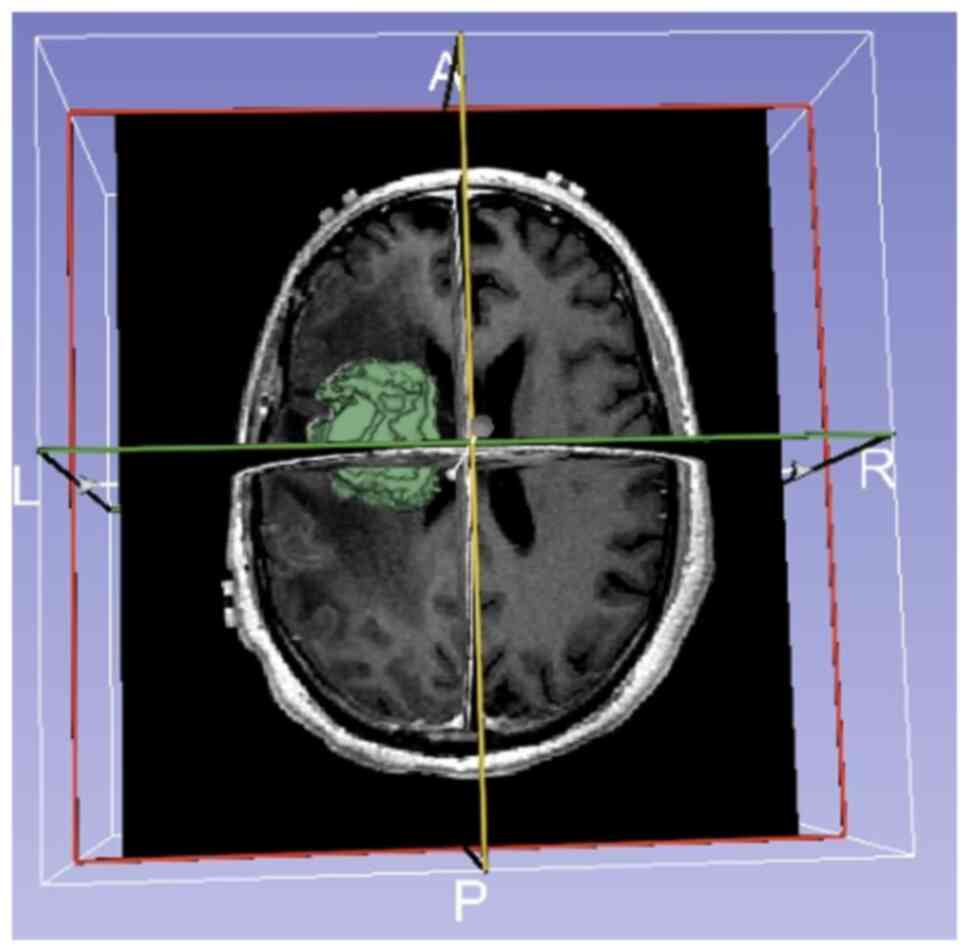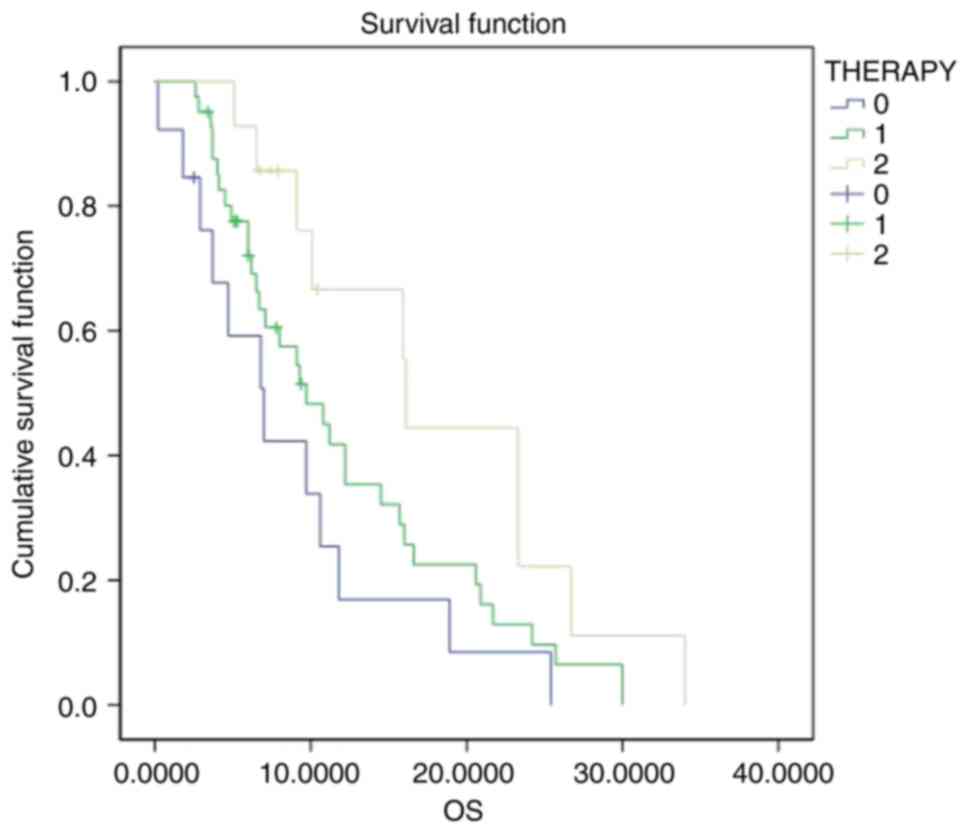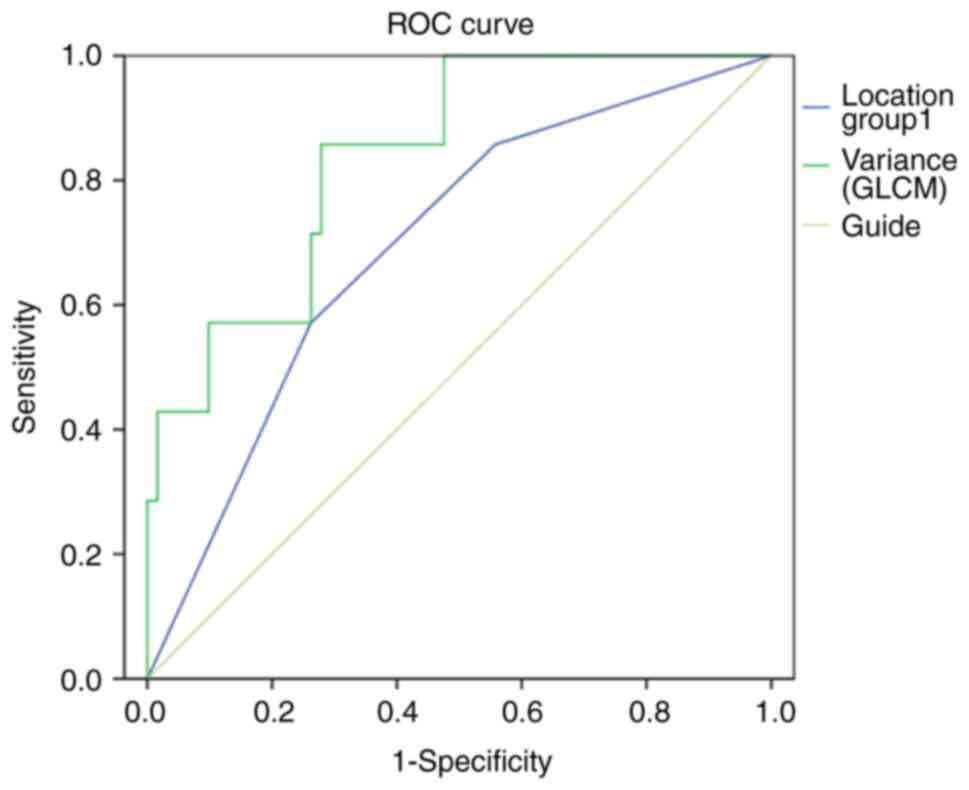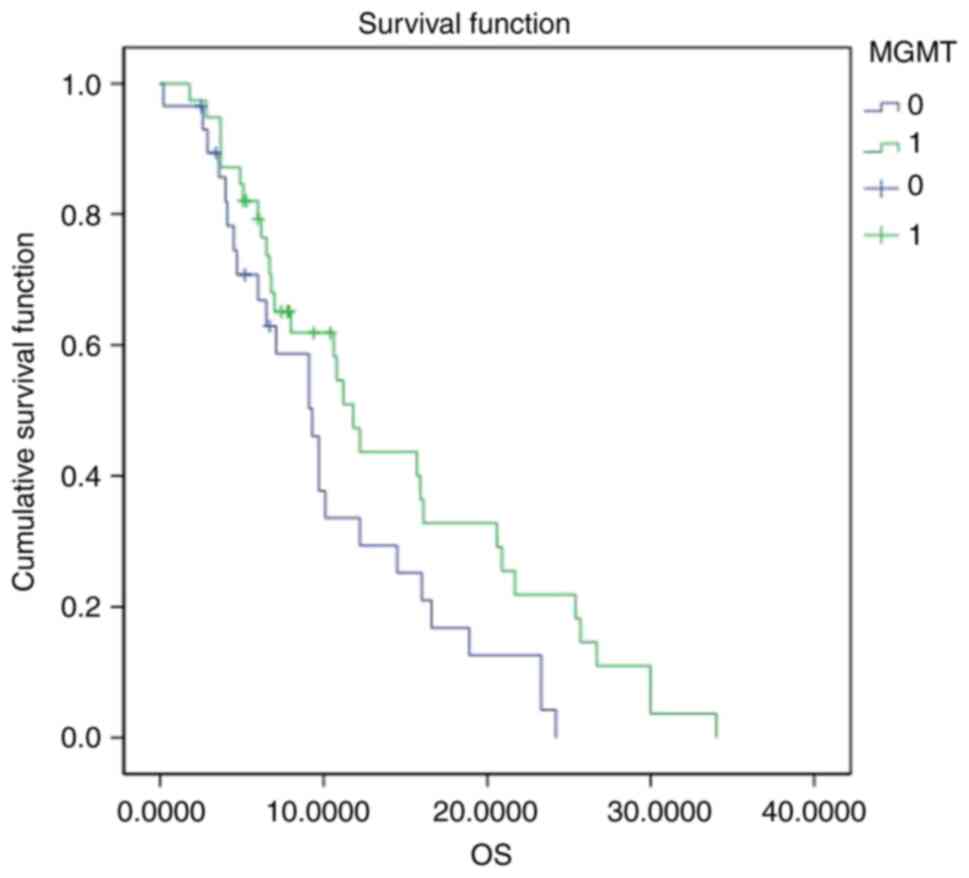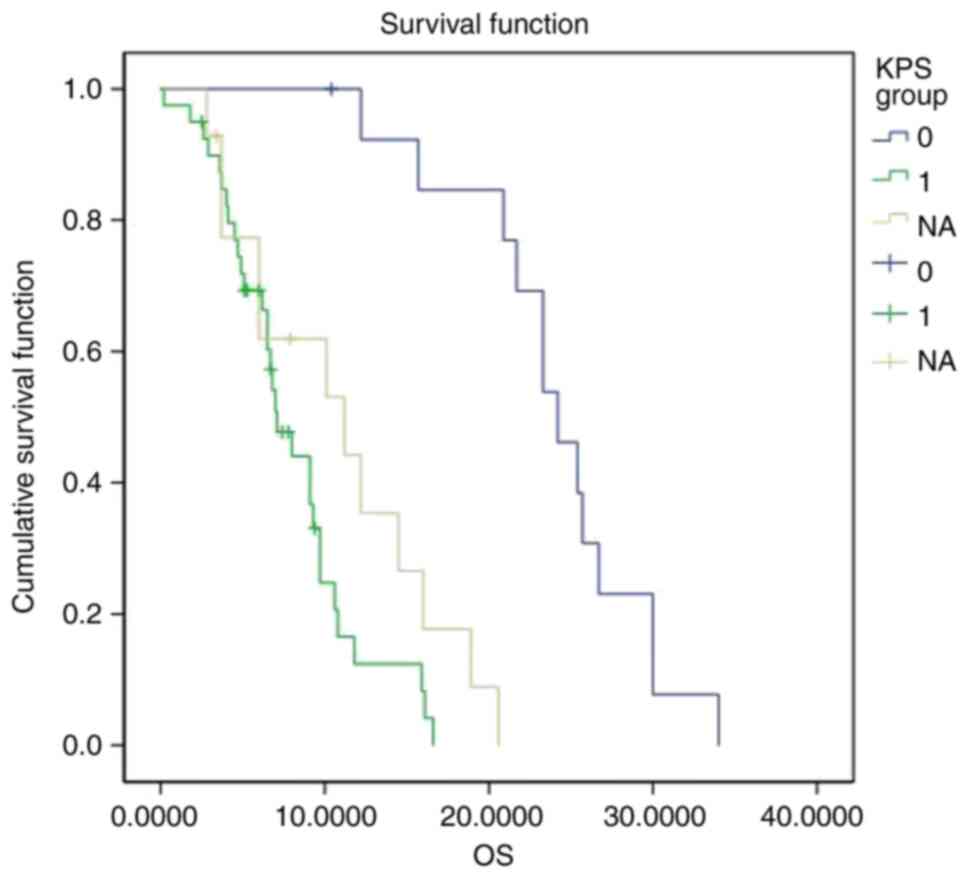Correlations of O6‑methylguanine DNA methyltransferase (MGMT) promoter methylation status with magnetic resonance imaging texture features and prognosis of glioblastomas
- Authors:
- Published online on: November 12, 2024 https://doi.org/10.3892/mco.2024.2803
- Article Number: 8
-
Copyright: © Wang et al. This is an open access article distributed under the terms of Creative Commons Attribution License.
Abstract
Introduction
Gliomas are the most common tumors of the central nervous system (CNS). The 2014 International Congress of Neuropathology added molecular findings to the diagnostic guidelines for brain tumors, whereas in 2016, the World Health Organization (WHO) classification standard introduced molecular features in the reclassification of CNS tumors (1). This included diffuse astrocytomas, oligodendrogliomas, ependymomas, choroid plexus tumors, neuronal and mixed neuronal-glial tumors, pineal region tumors and embryonal tumors (1). The 2021 edition of the classification standard highlighted the role of molecular diagnostics in the classification of CNS tumors (2). It integrated histological classification with molecular phenotypes, which included IDH-1, MGMT, 1p/19q, BRAF and ATRX. Glioblastomas are the most common malignant tumors of the CNS, accounting for 46% of all CNS tumors. Patients with glioblastomas have a relatively poor prognosis, with a five-year survival rate of <5% (3). Identifying specific molecular phenotypes is crucial for individualized treatment. One such molecular phenotype involves detecting methylation of the O6-methylguanine DNA methyltransferase (MGMT) promoter, which is associated with the glioblastoma prognosis (4-11). MGMT is a DNA repair protein that reverses DNA damage caused by alkylating agents by removing the alkyl group from O6-alkyl-guanine. When the MGMT promoter is hypermethylated, MGMT expression is silenced, leading to the absence of MGMT-mediated DNA repair. The alkylating agent temozolomide capitalizes on this lack of repair to improve the survival rates in patients with glioblastomas (12-15). However, the invasiveness of pathological biopsy and the high cost of detecting the methylation status of MGMT promoter, poses challenges for implementing individualized treatment in patients with glioblastomas. Glioblastomas with different genotypes exhibit vast heterogeneity on both genetic and histopathological levels, including intratumoral spatial variation in cellularity, angiogenesis, extravascular extracellular matrix and areas of necrosis (16-18). This high intratumoral heterogeneity of glioblastoma is an indicator of tumor malignancy, as it reflects areas of high cell density, necrosis, hemorrhage and mucoid degeneration. Intratumoral heterogeneity is also an important factor affecting prognosis and is related to tumor grade (19-21).
While glioblastoma heterogeneity cannot be discerned with the naked eye, MRI texture feature analysis is a valuable tool. In the present study, the 3D Slicer software was employed to analyze the magnetic resonance imaging (MRI) texture features of glioblastoma heterogeneity. The primary aim was to facilitate the discrimination of glioblastoma molecular phenotypes and improve the accuracy of molecular imaging diagnosis. This approach aims to provide patients with individualized treatment, predicting and improving their prognosis, and enhancing their quality of life.
Materials and methods
General information
A total of 128 patients who were pathologically diagnosed with glioblastoma at Tangshan Gongren Hospital (Tangshan, China) between June 2018 and September 2020 were enrolled in the present retrospective study. General clinical data included the age, sex, preoperative Karnofsky performance status (KPS) score, treatment method and overall survival (OS) of patients. Inclusion criteria were as follows: i) Patients with complete and reliable clinical, pathological and imaging data; ii) patients who did not undergo radiotherapy, chemotherapy, or other neoadjuvant therapies before surgery; and iii) patients pathologically diagnosed with glioblastoma after surgery. The following exclusion criteria were applied: i) Patients with a history of other malignant tumors; ii) patients with postoperative complications, such as intracranial hematoma or intracranial infection; and iii) patients who succumbed due to other causes. All biopsied specimens were tested for MGMT promoter methylation. In the study population, 79 patients had glioblastomas with methylated MGMT promoters, and 49 patients had glioblastomas with unmethylated MGMT promoters. All patients underwent conventional and contrast-enhanced MRIs. The Institutional Review Board of the Ethics committee at the Tangshan Gongren Hospital (Tangshan, China) granted an exemption to obtain informed consent due to the use of anonymous data (approval no. GRYY-LL-2020-44). The Ethics Committee exempted informed consent because of the retrospective nature of the present study.
Detection of MGMT promoter methylation status
Nested methylation-specific polymerase chain reaction was performed to test the methylation status of the MGMT promoter. Assessment criteria were as follows: Samples with the corresponding fragments amplified using only the MGMT-U primer were unmethylated; samples with the corresponding fragments amplified using only the MGMT-M primer or both the MGMT-U and MGMT-M primers were methylated (22).
Testing methods
The Philips 3.0-T MRI scanner and 8-Channel Sense Head Coil were used on each patient to perform conventional and contrast-enhanced MRI including transverse T1-weighted (T1WI), transverse and sagittal T2-weighted (T2WI), transverse T2-weighted fluid-attenuated inversion recovery (T2-FLAIR), and contrast-enhanced T1WI (T1WI + C) imaging. Scan parameters were as follows. Transverse T1WI: repetition time (TR) 2,270 msec, echo time (TE) 20 msec, field of view (FOV) 196x196 mm, matrix 288x190, number of excitations 2, slice thickness 6 mm, interslice gap 1 mm. Transverse and sagittal T2WI: TR 2,500 msec, TE 90 msec, FOV 230x230 mm, matrix 420x306, number of excitations 2, slice thickness 6 mm, interslice gap 1 mm. Transverse T2-FLAIR: TR 8,000 ms, TE 120 msec, FOV 230x230 mm, matrix 304x216, number of excitations 2, slice thickness 6 mm, interslice gap 1 mm. T1WI + C: TR 200 msec, TE 2 msec, FOV 230x230 mm, matrix 256x256, number of excitations 2, slice thickness 6 mm, interslice gap 1 mm. For contrast-enhanced MRI, gadopentetate dimeglumine was injected intravenously at a dose of 0.1 ml/kg body weight and at a flow rate of 3 ml/sec.
Image processing
All patient MRI images were exported from the PACS workstation in DICOM format and imported into the 3D Slicer open-source software (version 4.4.0; available at: https://slicer.org/). First, three experienced neuroimaging experts extracted MRI texture features from the transverse T1WI + C images using the Editor module in 3D Slicer. The regions of interest were delineated manually on each slice to ensure that the tumor boundaries were delineated as accurately as possible, and the three experts reached a consensus for the reconstruction of the three-dimensional tumor model (Fig. 1). Second, the three experts used the Heterogeneity CAD extension module to extract the MRI texture features of the tumors. Subsequent analyses were performed only when the intraclass correlation coefficient of the region of interest delineated by the three experts was >0.75. Finally, first-order statistics on the following four aspects of MRI texture features were calculated: Morphology, shape, texture: gray level co-occurrence matrix (GLCM), and texture: Gray level run-length matrix.
Follow-up
Follow-up was mainly conducted through medical records reviews and telephone interviews. The follow-up queries included the following: Inquiring about postoperative survival status (death or survival) of the patient; for patients who had survived, inquiring about their general condition following postoperative radiotherapy and chemotherapy; for patients who had succumbed, inquiring about the specific cause of death; other information was determined from the medical records of patient. OS was defined as the period from the date of surgery to the date of the last follow-up or death.
Statistical analysis
Statistical analysis was performed using SPSS 22.0 (IBM Corp.). Among the variables obtained through the 3D Slicer program, those that were normally distributed and demonstrating homogenous variance were subjected to the independent samples t-test. By contrast, those with non-normal distributions or non-homogenous variance were subjected to the Mann-Whitney test, to analyze the association between MGMT promoter methylation status and glioblastoma MRI texture analysis. The Chi square test was performed on the relationship between glioblastomas with the methylated MGMT promoter and MRI features and location. P<0.05 was considered to indicate a statistically significant difference. Binomial logistic regression analysis was then performed to further analyze the predictive power of MRI features and texture analysis heterogeneity for MGMT promoter methylation. Receiver operating characteristic curves were generated to compare the diagnostic performance between these two methods. In addition, Kaplan-Meier univariate survival analysis was performed to analyze the factors affecting glioblastoma prognosis. The corresponding survival curves were plotted, and the log-rank test was performed. Finally, multivariate analysis was conducted using the Cox proportional hazards model to further analyze the relationship of the relevant factors with prognosis.
Results
Relationship between MGMT promoter methylation status and glioblastoma MRI texture features
Comparisons were made between glioblastomas with methylated and unmethylated MGMT promoters using 31 texture features extracted with 3D Slicer. Among those, seven texture features showed statistically significant differences between the two groups (P<0.05): Energy, Entropy, Uniformity, Autocorrelation, Variance (GLCM), Gray Level Non-Uniformity (GLN), and Cluster Shade (Table IA and B).
Relationship between MGMT promoter methylation and tumor location
The analysis revealed that glioblastomas with methylated MGMT promoters were predominantly located in the temporal lobe (Table II), with significant differences in the tumor location between the two groups (P=0.039).
Binomial logistic regression model and receiver operating characteristic (ROC) curve analysis
In the logistic regression model, glioblastomas with methylated MGMT promoters were primarily located in the temporal lobes [Model I, odds ratio (OR): 0.277, 95% confidence interval (95% CI): 0.100-0.766, P=0.013], which showed an area under the curve (AUC) of 0.679 (95% CI: 0.503-0.893). MRI texture analysis showed a significant difference in Variance (GLCM) (Model II, OR: 1.68, 95% CI, 1.030-1.582, P=0.005), with an AUC of 0.838 (95% CI, 0.701-0.976). Consequently, Model II demonstrated significantly improved diagnostic performance than that of Model I (Fig. 2, Table III).
Table IIIBinomial logistic regression model of the MRI features and texture features of MGMT promoter methylation. |
Factors affecting glioblastoma prognosis
Kaplan-Meier univariate survival analysis results are shown in Table IV. Briefly, a significant difference in OS between glioblastomas with methylated and unmethylated MGMT promoters was noticed (P=0.045; Fig. 3). The median survival for patients with methylated MGMT promoters was 11.8 months, whereas for patients with the unmethylated MGMT promoters the median survival time was 9.3 months. Thus, glioblastoma with methylated MGMT promoters had a significantly longer OS. When comparing patients with preoperative KPS scores ≥80 to those with scores <80, the median survival was 24.2 months for the former and 7.1 months for the latter, with a statistically significant difference (P<0.001). Thus, patients with preoperative KPS scores ≥80 had a longer OS (Fig. 4). Among the treatment groups, 33 patients received radiotherapy, 26 received chemotherapy, and 69 received concurrent chemoradiotherapy. The differences in OS among the three groups were statistically significant (P=0.035), with a median survival of 7.0 months for radiotherapy, 9.7 months for chemotherapy and 16.1 months for concurrent chemoradiotherapy. Thus, patients who received concurrent chemoradiotherapy had a significantly longer OS than those who received either radiotherapy or chemotherapy alone (Fig. 5). No significant differences in OS were found based on age, sex, or glioblastoma subtype.
Multivariate survival analysis
Multivariate survival analysis using the Cox proportional hazards model (Table V) showed the following results: The difference in OS between patients with preoperative KPS scores ≥80 and <80 was significant (P=0.032), with a hazard ratio (HR) of 2.315 and a 95% CI of 1.075-4.987. The OS among patients receiving different postoperative adjuvant therapies (radiotherapy, chemotherapy, or concurrent chemoradiotherapy) also showed a significant difference (P=0.033), with an HR of 2.817 and a 95% CI of 1.086-7.306. Patients receiving concurrent chemoradiotherapy had a significantly longer OS than that of patients receiving only radiotherapy or chemotherapy. No significant differences in glioblastoma prognosis were observed based on MGMT promoter methylation, age and sex.
Discussion
Owing to the extremely high malignancy and high invasiveness of glioblastoma, it has been difficult to achieve satisfactory outcomes using radiotherapy, chemotherapy, or concurrent chemoradiotherapy. Using the 3D Slicer, a visualization and data analysis tool used in MRI studies, the MRI texture features of glioblastoma with methylated and unmethylated MGMT promoters were compared. The present results identified seven MRI texture features [Energy, Entropy, Uniformity, Autocorrelation, Variance (GLCM), GLN and Cluster Shade] that showed significant differences between the two groups.
MGMT has been shown to be closely linked to glioblastoma (4-11). Different molecular phenotypes of glioblastoma can reflect the different biological states and processes of the body (23). Current literature suggests that the location of intracranial gliomas is related to the origin of the tumor cell genetic phenotype, and hence there is some correlation between tumor location and molecular phenotype (24). The current findings revealed a significant difference in tumor location between glioblastomas with methylated and unmethylated MGMT promoters, with the former mostly located in the temporal lobe. This observation is consistent with the results obtained by Li et al (25) and may be related to the origin and genetic alterations of mutations in MGMT promoter methylation. It mainly refers to texture features on T2-weighted images assessed by the space-frequency analysis, which were significantly different between methylated and unmethylated cases by Drabycz et al (26). The present retrospective study analyzed the correlation of MGMT promoter methylation with glioblastoma MRI texture features and prognosis. Although there are similarities between these two studies, there are still some differences.
Previously, Kickingereder et al (27) demonstrated the correlation between MRI texture features and molecular characteristics. However, the reliability and accuracy of software analysis used in such studies still require further improvement. In fact, only a few MRI studies have analyzed glioblastoma heterogeneity, and currently, there is no uniform standard among the software used. Currently available software includes OsiriX, MaZda and 3D Slicer. Among these, OsiriX is proprietary software dedicated to the Apple system, with special requirements for the imported data type and device model. Although MaZda is open-source software, it can only extract tumor information on a two-dimensional level and delineate tumor information layer by layer on images stored in the BMP format, which inevitably leads to loss of tumor information. 3D Slicer is one such open-source, freely available software used in the analysis and interpretation of medical imaging data. Over the past 20 years, the US National Institutes of Health (NIH) has allocated multiple grants for the creation of 3D Slicer, with the aim of achieving powerful medical image processing capabilities. This visualization and data analysis tool is extensible and has powerful plug-in capabilities, enabling the addition of algorithms and application programs. 3D Slicer is able to reconstruct the tumor volume in three-dimensional space, thereby capturing all available information about the tumor and minimizing the loss of tumor information. Egger et al (28) found that using the 3D Slicer semi-quantitative segmentation tool can improve the reliability of glioblastoma segmentation, overcoming the effects of human factors, and enabling the quantification of texture parameters while also yielding more intuitive and accurate values. By utilizing the Heterogeneity CAD extension module of 3D Slicer, 31 texture features of tumor heterogeneity were extracted. A total of seven MRI texture features with significant differences were identified between glioblastomas with methylated and unmethylated MGMT promoters. These features included Energy, Entropy, Uniformity, Autocorrelation, Variance (GLCM), GLN and Cluster Shade. MGMT promoters with variance showed particularly strong diagnostic performance. Glioblastomas with methylated MGMT promoters were frequently found in the temporal lobe. The present study also found that patients with higher preoperative KPS scores and those receiving concurrent chemotherapy have improved OS. Such findings raise the hope that texture features extracted using 3D Slicer can facilitate determining the MGMT promoter methylation status in patients with glioblastomas. The main texture features commonly used in clinic are energy, entropy and autocorrelation. Among them, energy is mainly related to the differences in the heterogeneity of tumor cells, which mainly reflects the arrangement of tumor cells. Entropy is a widely used texture feature in clinical practice and plays an important role in the diagnosis and treatment of various malignant tumors. Texture analysis based on T1WI-enhancement is expected to provide some help in identifying the methylation status of MGMT promoter in patients with GBM. By understanding the texture characteristics of magnetic resonance, the limitations of human eyes in evaluating tumors are overcome. At the same time, the results of texture analysis were quantified by quantitative extraction of parameters related to tumor heterogeneity.
Overall, the findings of the present study suggested that MRI texture analysis is a valuable, non-invasive, less-expensive method for detecting MGMT promoter methylation and personalizing treatment, potentially improving patient outcome. Despite providing such valuable information, this was a single-center study with a small sample size. Therefore, selection bias cannot be ruled out. Future studies should involve multicenter cooperation to verify the results of the present study.
Acknowledgements
Not applicable.
Funding
Funding: The present study was supported by the 2021 Hebei Medical Science Research Project Program (grant no. 20210447).
Availability of data and materials
The data generated in the present study may be requested from the corresponding author.
Authors' contributions
RW collected and analyzed data, post-processed imaging data, performed literature review and follow-up, and wrote the manuscript. ZS and HW confirm the authenticity of all the raw data, designed the project and revised the manuscript. JS and MM analyzed imaging data and performed statistical analysis. All authors read and approved the final version of the manuscript.
Ethics approval and consent to participate
The Institutional Review Board of the Ethics committee at the Tangshan Gongren Hospital (Tangshan, China) granted an exemption to obtain informed consent due to the use of anonymous data (approval no. GRYY-LL-2020-44). The Ethics Committee exempted informed consent because of the retrospective nature of the present study.
Patient consent for publication
Not applicable.
Competing interests
The authors declare that they have no competing interests.
References
|
Louis DN, Perry A, Reifenberger G, von Deimling A, Figarella-Branger D, Cavenee WK, Ohgaki H, Wiestler OD, Kleihues P and Ellison DW: The 2016 world health organization classification of tumors of the central nervous system: A summary. Acta Neuropathol. 131:803–820. 2016.PubMed/NCBI View Article : Google Scholar | |
|
Louis DN, Perry A, Wesseling P, Brat DJ, Cree IA, Figarella-Branger D, Hawkins C, Ng HK, Pfister SM, Reifenberger G, et al: The 2021 WHO classification of tumors of the central nervous system: A summary. Neuro-Oncology. 23:1231–1251. 2021.PubMed/NCBI View Article : Google Scholar | |
|
Ostrom QT, Gittleman H, Fulop J, Liu M, Blanda R, Kromer C, Wolinsky Y, Kruchko C and Barnholtz-Sloan JS: CBTRUS statistical report: Primary brain and central nervous system tumors diagnosed in the United States in 2008-2012. Neuro Oncol. 17 (Suppl):iv1–iv62. 2015.PubMed/NCBI View Article : Google Scholar | |
|
Della Monica R, Cuomo M, Buonaiuto M, Costabile D, Franca RA, Del Basso De Caro M, Catapano G, Chiariotti L and Visconti R: MGMT and whole-genome DNA methylation impacts on diagnosis, prognosis and therapy of glioblastoma multiforme. Int J Mol Sci. 23(7148)2022.PubMed/NCBI View Article : Google Scholar | |
|
Teske N, Karschnia P, Weller J, Siller S, Dorostkar MM, Herms J, von Baumgarten L, Tonn JC and Thon N: Extent, pattern, and prognostic value of MGMT promotor methylation: Does it differ between glioblastoma and IDH-wildtype/TERT-mutated astrocytoma? J Neurooncol. 156:317–327. 2022.PubMed/NCBI View Article : Google Scholar | |
|
Min TL, Allen JW, Velazquez Vega JE, Neill SG and Weinberg BD: MRI imaging characteristics of glioblastoma with concurrent gain of chromosomes 19 and 20. Tomography. 7:228–237. 2021.PubMed/NCBI View Article : Google Scholar | |
|
Pease M, Gersey ZC, Ak M, Elakkad A, Kotrotsou A, Zenkin S, Elshafeey N, Mamindla P, Kumar VA, Kumar AJ, et al: Pre-operative MRI radiomics model non-invasively predicts key genomic markers and survival in glioblastoma patients. J Neurooncol. 160:253–263. 2022.PubMed/NCBI View Article : Google Scholar | |
|
Zhang M, Chen HZ, Cui YY, Zhang ZZ and Ma XD: The associations between preoperative conventional MRI features and genetic biomarker status in newly diagnosed GBMs: A clinical summary and prognostic analysis. Turk Neurosurg. 31:880–887. 2021.PubMed/NCBI View Article : Google Scholar | |
|
Do DT, Yang MR, Lam LHT, Le NQK and Wu YW: Improving MGMT methylation status prediction of glioblastoma through optimizing radiomics features using genetic algorithm-based machine learning approach. Sci Rep. 12(13412)2022.PubMed/NCBI View Article : Google Scholar | |
|
Verduin M, Primakov S, Compter I, Woodruff HC, van Kuijk SMJ, Ramaekers BLT, te Dorsthorst M, Revenich EGM, ter Laan M, Pegge SAH, et al: Prognostic and predictive value of integrated qualitative and quantitative magnetic resonance imaging analysis in glioblastoma. Cancers (Basel). 13(722)2021.PubMed/NCBI View Article : Google Scholar | |
|
Safaei R, Mojtahedi H, Hanaei S, Razavi A, Esmaeili M, Sadr M, Rezaei A, Edalatfar M, Kashani HK, Sadeghi-Naini M, et al: MGMT gene rs1625649 polymorphism in Iranian patients with brain glioblastoma: A case control study. Avicenna J Med Biotechnol. 15:48–52. 2023.PubMed/NCBI View Article : Google Scholar | |
|
Kitange GJ, Mladek AC, Carlson BL, Schroeder MA, Pokorny JL, Cen L, Decker PA, Wu W, Lomberk GA, Gupta SK, et al: Inhibition of histone deacetylation potentiates the evolution of acquired temozolomide resistance linked to MGMT upregulation in glioblastoma xenografts. Clin Cancer Res. 18:4070–4079. 2012.PubMed/NCBI View Article : Google Scholar | |
|
Blakstad H, Brekke J, Rahman MA, Arnesen VS, Miletic H, Brandal P, Lie SA, Chekenya M and Goplen D: Survival in a consecutive series of 467 glioblastoma patients: Association with prognostic factors and treatment at recurrence at two independent institutions. PLoS One. 18(e0281166)2023.PubMed/NCBI View Article : Google Scholar | |
|
Kurdi M, Shafique Butt N, Baeesa S, Alghamdi B, Maghrabi Y, Bardeesi A, Saeedi R, Al-Sinani T, Alghanmi N, Bari MO, et al: The impact of IDH1 mutation and MGMT promoter methylation on recurrence-free interval in glioblastoma patients treated with radiotherapy and chemotherapeutic agents. Pathol Oncol Res. 27(1609778)2021.PubMed/NCBI View Article : Google Scholar | |
|
Haque W, Thong E, Andrabi S, Verma V, Butler BE and the BS: Prognostic and predictive impact of MGMT promoter methylation in grade 3 gliomas. J Clin Neurosci. 85:115–121. 2021.PubMed/NCBI View Article : Google Scholar | |
|
Davnall F, Yip CS, Ljungqvist G, Selmi M, Ng F, Sanghera B, Ganeshan B, Miles KA, Cook GJ and Goh V: Assessment of tumor heterogeneity: An emerging imaging tool for clinical practice? Insights Imaging. 3:573–589. 2012.PubMed/NCBI View Article : Google Scholar | |
|
Ladenhauf VK, Galijasevic M, Kerschbaumer J, Freyschlag CF, Nowosielski M, Birkl-Toeglhofer AM, Haybaeck J, Gizewski ER, Mangesius S and Grams AE: Peritumoral ADC values correlate with the MGMT methylation status in patients with glioblastoma. Cancers (Basel). 15(1384)2023.PubMed/NCBI View Article : Google Scholar | |
|
Qureshi SA, Hussain L, Ibrar U, Alabdulkreem E, Nour MK, Alqahtani MS, Nafie FM, Mohamed A, Mohammed GP and Duong TQ: Radiogenomic classification for MGMT promoter methylation status using multi-omics fused feature space for least invasive diagnosis through mpMRI scans. Sci Rep. 13(3291)2023.PubMed/NCBI View Article : Google Scholar | |
|
Eccles SA and Welch DR: Metastasis: Recent discoveries and novel treatment strategies. Lancet. 369:1742–1757. 2007.PubMed/NCBI View Article : Google Scholar | |
|
Saxena S, Jena B, Mohapatra B, Gupta N, Kalra M, Scartozzi M, Saba L and Suri JS: Fused deep learning paradigm for the prediction of O6-methylguanine-DNA methyltransferase genotype in glioblastoma patients: A neuro-oncological investigation. Comput Biol Med. 153(106492)2023.PubMed/NCBI View Article : Google Scholar | |
|
Choi HJ, Choi SH, You SH, Yoo RE, Kang KM, Yun TJ, Kim JH, Sohn CH, Park CK and Park SH: MGMT promoter methylation status in initial and recurrent glioblastoma: Correlation study with DWI and DSC PWI features. AJNR Am J Neuroradiol. 42:853–860. 2021.PubMed/NCBI View Article : Google Scholar | |
|
Yaltirik CK, Yilmaz SG, Ozdogan S, Bilgin EY, Barut Z, Ture U and Isbir T: Determination of IDH1, IDH2, MGMT, TERT and ATRX gene mutations in glial tumors. In Vivo. 36:1694–1702. 2022.PubMed/NCBI View Article : Google Scholar | |
|
Ius T, Pignotti F, Della Pepa GM, Bagatto D, Isola M, Battistella C, Gaudino S, Pegolo E, Chiesa S, Arcicasa M, et al: Glioblastoma: From volumetric analysis to molecular predictors. J Neurosurg Sci. 66:173–186. 2022.PubMed/NCBI View Article : Google Scholar | |
|
Sanai N, Alvarez-Buylla A and Berger MS: Neural stem cells and the origin of gliomas. N Engl J Med. 353:811–822. 2005.PubMed/NCBI View Article : Google Scholar | |
|
Li HY, Sun CR, He M, Yin LC, Du HG and Zhang JM: Correlation between tumor location and clinical properties of glioblastomas in frontal and temporal lobes. World Neurosurg. 112:e407–e414. 2018.PubMed/NCBI View Article : Google Scholar | |
|
Drabycz S, Roldán G, Robles P, Adler D, Mcintyre J, Magliocco A, Cairncross JG and Mitchell JR: An analysis of image texture, tumor location, and MGMT promoter methylation in glioblastoma using magnetic resonance imaging. Neuroimage. 49:1398–1405. 2010.PubMed/NCBI View Article : Google Scholar | |
|
Kickingereder P, Bonekamp D, Nowosielski M, Kratz A, Sill M, Burth S, Wick A, Eidel O, Schlemmer HP, Radbruch A, et al: Radiogenomics of glioblastoma: Machine learning-based classification of molecular characteristics by using multiparametric and multiregional MR imaging features. Radiology. 281:907–918. 2016.PubMed/NCBI View Article : Google Scholar | |
|
Egger J, Kapur T, Fedorov A, Pieper S, Miller JV, Veeraraghavan H, Freisleben B, Golby AJ, Nimsky C and Kikinis R: GBM volumetry using the 3D slicer medical image computing platform. Sci Rep. 3(1364)2013.PubMed/NCBI View Article : Google Scholar |



